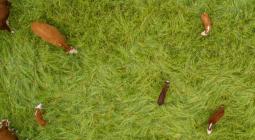The most damaging farm products? Organic, pasture-fed beef and lamb
Ranching’s capital account is always in debt, because wild ecosystems store more carbon than the fields and pastures that have taken their place. These debts can be enormous. A study of carbon opportunity costs published in Nature found that, while the global average cost of soybeans is 17kg of carbon dioxide for each kilogram of protein, the average carbon opportunity cost of a kilogram of beef protein is an astounding 1,250kg. Another paper calculates that if we all shifted to a plant-based diet, the carbon drawn down from the atmosphere by recovering ecosystems would be equivalent to the world’s fossil fuel emissions from the previous 16 years.
The livestock industry has fought back with a massive public relations campaign, seeking to persuade people that pasture-fed meat helps reduce global heating by storing carbon in the soil. Yet, despite the many claims, there is no empirical evidence that carbon storage in pastures can even compensate for grazing’s current account emissions, let alone address the capital debt. Just as the oil industry tried to convince us that CO2 was good for the planet on the grounds that it’s “plant food”, the ranching industry has sought to sow doubt and confusion about its vast environmental impacts.
We live in a bubble of delusion about where our food comes from and how it is produced. We’ve been dealing in stories when we should be dealing in numbers. Our gastroporn aesthetics, embedded in bucolic fantasy, are among the greatest threats to life on Earth.
George Monbiot’s book Regenesis: Feeding the World Without Devouring the Planet, is published by Penguin.



